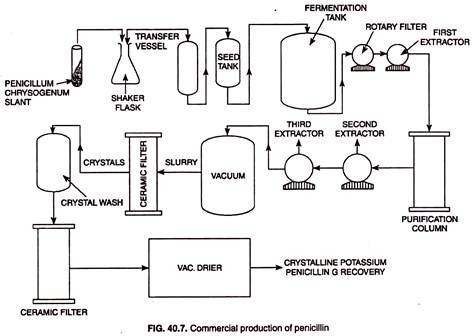In this article we will discuss about the discovery and commercial production of penicillin.
Discovery of Penicillin:
Alexander Flemming discovered penicillin secretion by the mold Penicillium notatum in 1929. He reported that a contaminating colony of the fungus lysed adjacent colonies of staphylococci; but the lytic agent seemed too unstable to be useful. However, when Chain purified the active material, called penicillin, in 1939, it proved remarkably effective in certain infections.
Penicillin is not a single chemical compound, but a group of compounds of related structure and activity. There are six penicillins – Penicillin G (benzyl penicillin), penicillin V (phenoxy-methyl penicillin), penicillin F (A2-pentcnyl penicillin), penicillin X (p-hydroxybenzyl penicillin), penicillin K (n-heptyl penicillin) and penicillin O (allyl-mercaptomethyl penicillin). Penicillin is selective for gram-positive bacteria, some spirochaetcs and the gram-negative diplococci (Neisseria).
Commercial Production of Penicillin:
Commercial production of penicillin is depicted in Fig. 40.7. The commercial production of most of the antibiotics follows a similar plan. The major differences relate to the microorganism, media composition, and extraction procedure. For penicillin production, inoculum of a high yielding strain of P. chrysogenum is prepared as follows: inoculum is first cultured in flasks in wheat bran nutrient solution for 1 week at 24°C.
The culture is then transferred to inoculum tanks, and grown for 1-2 days under aeration; this supports heavy mycelial growth. The inoculum is now added to very large fermentors containing the production medium, which consists of 10 per cent total glucose/molasses, 4-5% corn-steep liquor solids, 0.5-0.8 per cent phenylacetic acid and 0.5% vegetable oil; pH is adjusted to 6.0 and temperature is regulated at 25- 26°C.
Earlier media contained lactose, but it is no longer used. The fermentation is carried out under aerobic conditions, and nutrient supply is maintained by regular feeding (fed-batch culture). The fungus grows in a submerged culture mostly as mycelial balls.
The fermentation is carried out for 7 days. Initially, mycelial growth occurs, and carbohydrates are used up. This reduces the carbohydrate level in the medium; this favours penicillin production, which begins from the second day of fermentation. The pH of medium rises to 8.0 by the 7th day, and penicillin production stops at this stage. Phenylacetic acid is the precursor for the benzene ring side chain of Penicillin G.
The presence of precursor promotes the production of Penicillin G. At the end of fermentation period, the fungal biomass is separated by filtration and used as animal feed supplement. Penicillin G is present in the broth, and is extracted using an organic solvent. Penicillin G is finally purified as potassium salt; it is converted to 6-aminopenicillanic acid (6-APA) cither chemically or biologically.
The side chain of 6-APA is variously modified to obtain a variety of derivatives of penicillin, which are used in medicine. In addition, several other fungal metabolites are used as antibiotics (Table 40.3).

